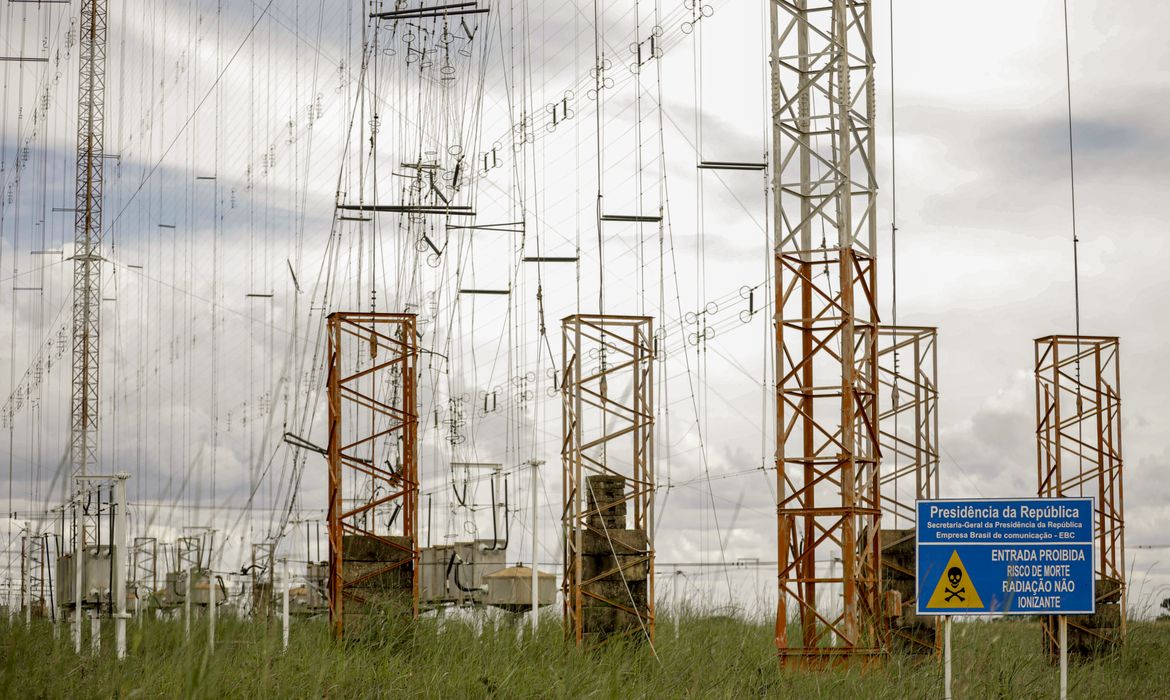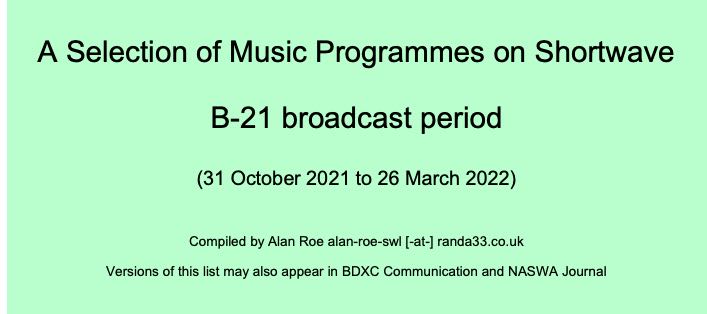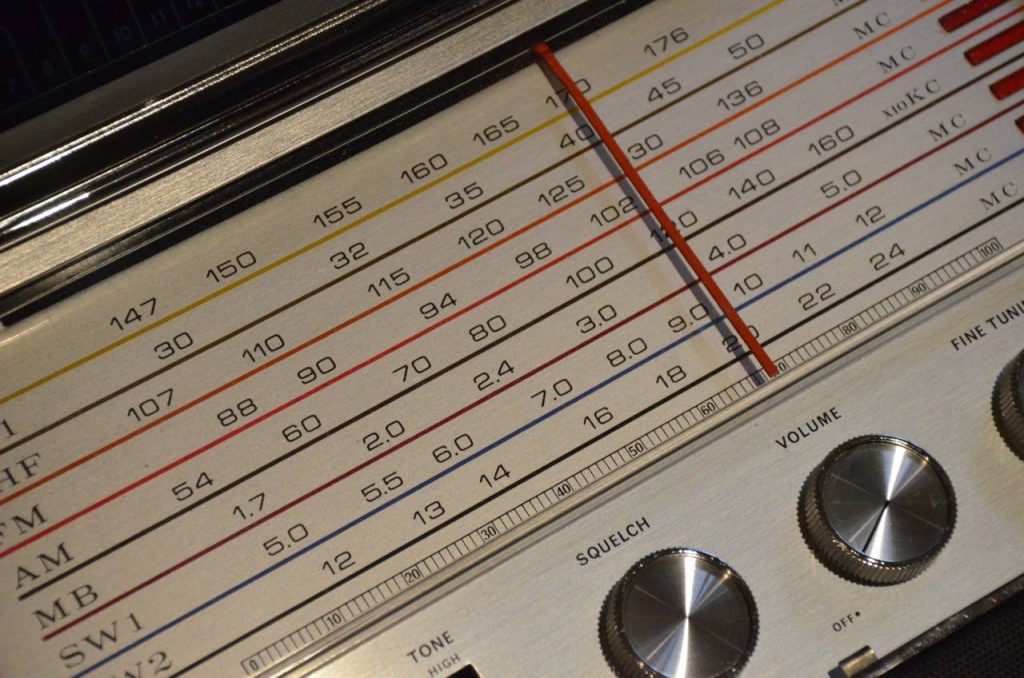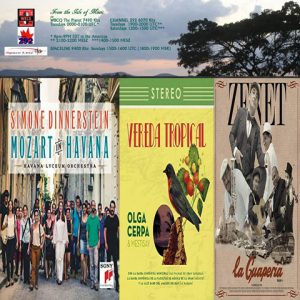The facility 40km northwest of Brasilia originally cost $15 Million USD to build and will turn 50 years old on March 11, 2024. It’s home to several SW, AM and FM transmitters , including Radio Nacional de Amazonias on 6180 and 11780khz. The stations owner, Empresa Brasil de Comunicação , a government owned agency plans to recognize the facility’s Gold anniversary.
Category Archives: Program Spotlight
Alan Roe’s B-21 season guide to music on shortwave
Many thanks to SWLing Post contributor, Alan Roe, who shares his B-21 season guide to music on shortwave.
Click here to download Music on Shortwave B-21 (PDF)
Thank you for sharing your excellent guide, Alan!
Short Waves / Short Poems first episode
Many thanks to SWLing Post contributor, T. D. Walker, who shares the following announcement:
Short Waves / Short Poems is a 15 minute program that features poets reading their work. Attention to a poem parallels in many ways attention to a shortwave radio broadcast–both require a deliberate searching for and listening to the medium. I also wanted to explore what it means to put an art that is undergoing a resurgence on a medium that seems to be diminishing in its reach. And above all that, I wanted to bring good poetry to shortwave listeners.
Our first episode will air Saturday 14 December at 2am UTC on 5130kHz, and it will feature work by poets Deborah L. Davitt, Amy Lowell, and A.J. Odasso, all of which use storms as a way to examine the workings of love, loss, and contemplation. We’re planning on running weekly for four weeks, with different poets each episode.
More information about the show is at our website: www.
We’re happy to receive reception reports, and QSL cards are available. You can reach us via email at [email protected] or via postal mail at Short Waves / Short Poems, PO Box 515622, Dallas, TX 75251, USA.
And a bit about me: I’m the author of Small Waiting Objects (CW Books, 2019), and my poems and science fiction stories have appeared in Strange Horizons, The Future Fire, Web Conjunctions, The Cascadia Subduction Zone, Abyss & Apex, Kaleidotrope, and elsewhere. As a longtime radio enthusiast, I’m delighted to be able to combine my aim to bring poetry to a wider audience with my interest in shortwave radio.
Readers, please note that 2:00 AM UTC on Saturday is 9:00 PM EST/ 6:00 PM PST today (Friday).
FTIOM & UBMP, July 7-13
From the Isle of Music, July 7-13:
This week, we listen to some of the International Prize winners of Cubadisco 2019. Some of the music is classical, and some of it is for dancing.
The broadcasts take place:
1. For Eastern Europe but audible well beyond the target area in most of the Eastern Hemisphere (including parts of East Asia and Oceania) with 100Kw, Sunday 1500-1600 UTC on SpaceLine, 9400 KHz, from Sofia, Bulgaria (1800-1900 MSK)
If you don’t have a shortwave radio or are out of range, you can listen live to an uplink from a listening radio in the Netherlands during the broadcast at
http://websdr.ewi.utwente.nl:8901/?tune=9400am
2. For the Americas and parts of Europe, Tuesday 0000-0100 UTC (New UTC) on WBCQ, 7490 KHz from Monticello, ME, USA (Monday 8-9PM EST in the US).
If you don’t have a shortwave or are out of range, you can listen to a live stream from the WBCQ website here (choose 7490)
http://www.wbcq.com/?page_id=7
3 & 4. For Europe and sometimes beyond, Tuesday 1900-2000 UTC and Saturday 1200-1300 UTC on Channel 292, 6070 KHz from Rohrbach, Germany.
If you don’t have a shortwave radio or are out of range, you can listen live to an uplink from a listening radio in the Netherlands during the broadcast at
http://websdr.ewi.utwente.nl:8901/?tune=6070am
Uncle Bill’s Melting Pot, July 7 and 9:
Episode 120 examines US protest songs from different decades.
The transmissions take place:
1.Sundays 2200-2230 UTC (6:00PM -6:30PM Eastern US) on WBCQ The Planet 7490 KHz from the US to the Americas and parts of Europe
If you don’t have a shortwave or are out of range, you can listen to a live stream from the WBCQ website here (choose 7490)
http://www.wbcq.com/?page_id=7
2. Tuesdays 2000-2030 UTC on Channel 292, 6070 KHz from Rohrbach, Germany for Europe.
If you don’t have a shortwave radio or are out of range, you can listen live to an uplink from a listening radio in the Netherlands during the broadcast at
http://websdr.ewi.utwente.nl:8901/?tune=6070am
FTIOM & UBMP, June 30-July 6
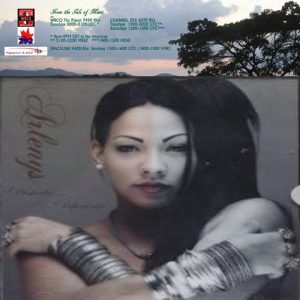

From the Isle of Music, June 30–July 6:
This week our special guest is Arlenys Rodríguez, who in addition to her own projects has performed with NG La Banda and collaborated with several other artists.
The broadcasts take place:
1. For Eastern Europe but audible well beyond the target area in most of the Eastern Hemisphere (including parts of East Asia and Oceania) with 100Kw, Sunday 1500-1600 UTC on SpaceLine, 9400 KHz, from Sofia, Bulgaria (1800-1900 MSK)
If you don’t have a shortwave radio or are out of range, you can listen live to an uplink from a listening radio in the Netherlands during the broadcast at
http://websdr.ewi.utwente.nl:8901/?tune=9400am
2. For the Americas and parts of Europe, Tuesday 0000-0100 UTC (New UTC) on WBCQ, 7490 KHz from Monticello, ME, USA (Monday 8-9PM EST in the US).
If you don’t have a shortwave or are out of range, you can listen to a live stream from the WBCQ website here (choose 7490)
http://www.wbcq.com/?page_id=7
3 & 4. For Europe and sometimes beyond, Tuesday 1900-2000 UTC and Saturday 1200-1300 UTC on Channel 292, 6070 KHz from Rohrbach, Germany.
If you don’t have a shortwave radio or are out of range, you can listen live to an uplink from a listening radio in the Netherlands during the broadcast at
http://websdr.ewi.utwente.nl:8901/?tune=6070am
Uncle Bill’s Melting Pot, June 30 and July 2, 2019:
Episode 119 features Klezmer music old and new.
The transmissions take place:
1.Sundays 2200-2230 UTC (6:00PM -6:30PM Eastern US) on WBCQ The Planet 7490 KHz from the US to the Americas and parts of Europe
If you don’t have a shortwave or are out of range, you can listen to a live stream from the WBCQ website here (choose 7490)
http://www.wbcq.com/?page_id=7
2. Tuesdays 2000-2030 UTC on Channel 292, 6070 KHz from Rohrbach, Germany for Europe.
If you don’t have a shortwave radio or are out of range, you can listen live to an uplink from a listening radio in the Netherlands during the broadcast at
http://websdr.ewi.utwente.nl:8901/?tune=6070am
From the Isle of Music for August 15/16
From The Isle of Music reports:
Our August 16 (August 15 in the Americas on WBCQ) program
marks the beginning of several weeks of Caribe Nostrum, winner of Cubadisco 2016 in the Concert and Chamber Music category and one of the two Gran Premio winners. Guido López Gavilán, the Director, will join us each week to talk about the recording. Our other special guest will be Roberto Carcasses, leader of Interactivo, one of the most exciting modern music ensembles in Cuba today. And, of course, we will have a few other musical surprises.
Two options for listening on shortwave:
WBCQ, 7490 KHz, Tuesdays 0000-0100 UTC
(8pm-9pm EDT Mondays in the Americas)
Channel 292, 6070 KHz, Tuesdays 1900-2000 UTC
(2100-2200 CEST)
See the NOTES section of our Facebook page for more information.
From the Isle of Music for July 11/12 on WBCQ and Channel 292
From the Isle of Music…….
The July 12 (July 11 in the Americas on WBCQ) program includes special guest María Felicia Pérez, director of Coro Exaudi, winner of the Choral Music category in Cubadisco 2016. We’ll also play some Popular Dance Music by TImbalive, nominated in the Dance Music – New Talents category and some of Pasos by Maikel Vistel, which was nominated in the Jazz category in Cubadisco. Also, some songs from a couple of decades back by Adalberto Álvarez
Two listening options on shortwave:
WBCQ, 7490 KHz, Tuesdays 0000 UTC (8pm EDT Mondays)
Channel 292, 6070 KHz, Tuesdays 1900 UTC (2100 CEST)
See the NOTES section of the FTIOM Facebook page for more information

